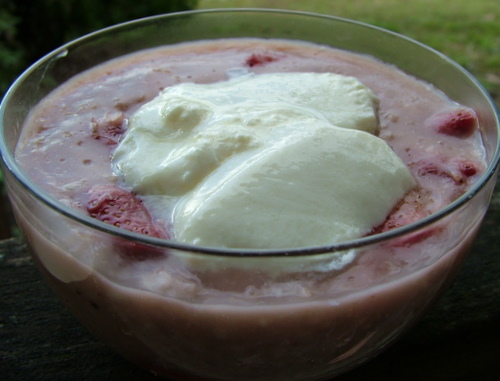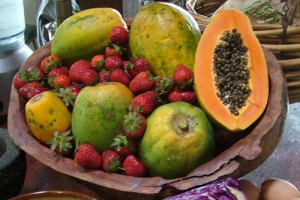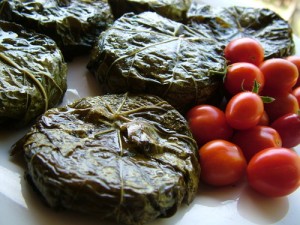If you’ve been following The Breakfast Challenge then you’ll know I’m a bit ambivalent about porridge. I’m trying to like it. Oats for breakfast are hugely healthy – low GI, cholesterol busting, lots of B vitamins, minerals and phytochemicals – but regular old porridge is a bit bland for my tastes, unless it’s loaded up with brown sugar and cream, which sort of defeats the purpose.
So this is my kind of porridge – porridge with the flavours cranked right up. But it needs a warning. Half the people I’ve tried it with love it (including me), half find it too confronting. I think the test is, do you like pickled ginger? Or crystallized ginger? That sweet-hot combination? Then you will probably like this.
I’ve also added my recipe for skim milk yoghurt. There are quite a few good recipes for yoghurt online, including Christine at Slow Living Essentials and Rhonda at Down To Earth. I’ve avoided posting mine because I’m not sure which bits are really necessary to make it work and which bits are superstition! But someone asked me in a Comment for my Skim Milk Yoghurt recipe, so here it is.
First the Spiced Strawberry Porridge Recipe:
For a single serve:
In a small pot, over a medium heat (too high and it will boil over) cook for around 5 minutes:
- 1/3 cup plain (not quick) rolled oats
- 2 cups of water
- ¼ teaspoon of finely grated fresh ginger (start with ¼ – I like a bit more)
- 1 good teaspoon of honey
- good pinch salt
- good pinch freshly ground black pepper ( Not as strange as it seems -strawberries and pepper are a classic combination)
- little pinch powdered cloves
While it is cooking, hull and halve a cup of strawberries.
When the porridge is nearly thick enough, add the strawberries and continue cooking, stirring occasionally, for a couple of minutes longer. You want the strawberries to be just softened and the porridge turning pink.
Serve with a dollop of:
Skim Milk Yoghurt
Ok, this is deceptively simple but there’s lots of chemistry involved.
- You want skim milk with the whey proteins denatured by heat.
- You want slightly more milk solids than in regular liquid milk.
- You want as little dissolved oxygen as possible.
- You want the yoghurt bug and no others.
- And you want a nice warm environment for the yoghurt culture to grow in for 10 to 16 hours.
So, my method is to use powdered skim milk. This already has the the proteins changed in the process of powdering, and I can make it a bit strong. If you use fresh skim milk, you need to add a spoonful or two of powdered milk, and heat it up till it just starts to rise, then cool it down again.
I mix it fairly gently by shaking, not using a blender or eggbeater, to avoid incorporating air, and once it is made, I leave it right alone – no shaking, stirring or hassling at all.
I use boiled water to mix it, and I sterilized the jar I make it in (by pressure cooking it for 5 minutes) originally, so as to eliminate competition from other cultures. (I have tank water with no chlorine, so maybe you don’t need to do this.) Then I just make another batch in the same jar, using the last of the last batch as the starter.
And I use a variety of methods to keep it all warm long enough – the warming oven in the wood stove, a wide mouthed thermos filled with hot water, a blanket and the dashboard of the car out in the sun.
The Recipe (Adapt to Suit)
If you are making it for the first time, sterilize a jar and its lid. Once you have a jar going, you can just keep using it.
In the sterile jar, put
- 2 big spoonfuls of plain yoghurt from your last batch, or bought yoghurt of a similar kind (I used Yalna Low Fat Greek Yoghurt)
- ½ cup of skim milk powder, plus 2 dessertspoons more powder. I make these last two spoonfuls full cream milk powder, just to add that little bit of richness, but it works with all skim milk powder.
- 1½ cups of boiled water, cooled to just a bit warmer than “baby bath” temperature.
Put the lid on and tip the jar upside down then up again enough times to dissolve the powder and the yoghurt, without getting it all frothy.
Tip a kettle full of nearly boiling water into a wide mouthed thermos and put the jar, with its lid on, in the thermos. Put the lid on the thermos, wrap the lot in a towel, and leave it sit without disturbance for 8 hours. Check. If the water has cooled down, refill the thermos with nearly boiling water and leave it alone again. It takes between 10 and 16 hours to set, depending, I think, on how vigorous the original culture was.
When it is set you can put it in the fridge, or use it to make labne. Don’t forget to leave the last two spoonfuls in the jar to make the next batch.





Hi Linda, I hardly ever comment here because I read the blog through google reader but just wanted to say that I really look forward to your posts! I am a total porridge addict so all the porridge variations this year have been really welcome. I’m gearing up for plum season here in Buenos Aires so planning some plum porridge (and jam and crumble and chutney and anything else with plums) soon. xx
This recipe for porridge sounds lovely Linda…i really love porridge but just never seem to have time in mornings anymore…perhaps need to make at night ready for the morning.
Really want to give your yoghurt recipe a go too, i have often read Rhonda’s and thought i have to do that!hmmm, so many things to try….thanks for stopping by my blog too!
Jode x
We should start getting plums soon too Victoria. Looking forward to it.
Pingback:Early November’s 2 Fruit 5 Veg
Pingback:The Breakfast Challenge – French Toast with Honey Balsamic Glazed Strawberries